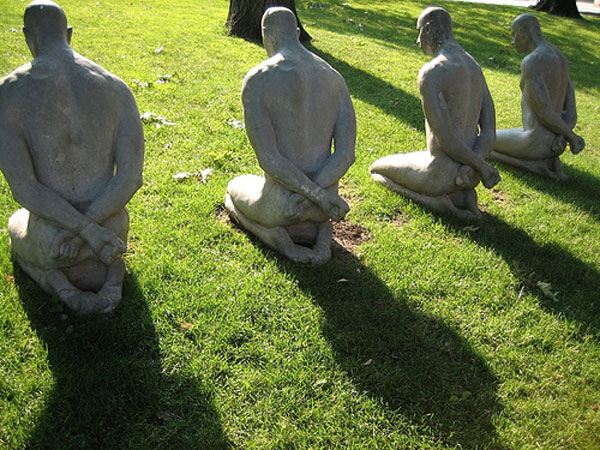-
Voyeur Eyes Only: On Glass Houses and Art Committees
by Raphael Ruttenberg June 18, 2010

Much has been made lately of our new luxury buildings clad entirely in glass. In a city as densely populated as New York, each new transparency evokes a stack of terrariums: Eames chairs, antique ceramics, mixed-media paintings, and the occupants themselves are all offered for our consideration. Viewed by the passerby, the small, silent vignettes of the lives on display are as conspicuous as the luxury possessions that hold court in their absence.
In the past, residential buildings communicated the privilege within by swaddling their facades in ornamental detail, often channeling the history of an absent aristocracy. Manhattan’s Ansonia and Dakota buildings invoke a Parisian and a North German style, respectively. The towers lining Park Avenue and the white brick buildings smattering the Upper East Side, though not as ornate, rely on their facades to reinforce the status of their location. These opaque exteriors remind the public that its inhabitants are well-to-do, and are thus shielded from the unwashed masses flowing past. If these edifices tend to look somewhat like castles, it is hardly an accident.
The building known as On Prospect Park, at 1 Grand Army Plaza, inverts the traditional exclusion of the street from the living spaces of its inhabitants. The building does not sit on the park, as it’s name implies, but rather catty-corner to the main entrance, across the street from the Brooklyn Public Library. Walking along Eastern parkway, it is impossible not to gaze through the wall of glass windows into any number of the apartments housed within. Even by the standards of the day, On Prospect Park provides the would-be voyeur with a view of unprecedented acuity. Here, certainly, is the contemporary domain of the wealthy: who else could afford such a remarkable building? And who else would possess such confidence in their material prizes to offer their image to the world?

The building has recently inverted another trapping of old money. Immediately to the right of the entry foyer is a room containing several sculptures by Raphael Zollinger. The space appears to be a tightly-packed gallery, but it in fact serves as a sculpture garden for building residents. ‘Sculpture garden’ brings to mind public parks where artworks are arrayed for collective enjoyment, though it often signifies the opposite, indicating private places of repose found within the gilded manses of the very rich. In the past, such gardens were a decadence found only in homes of those rich enough to afford the requisite space, and educated enough to appreciate the beauty of fine art. Thus the sense of privacy and exclusion, where the gentleman can enjoy his material gains apart from the less well-appointed outside world.
One Grand Army Plaza’s sculpture garden is, like the rest of its contents, viewable from the street. A short concrete planter prevents one from walking directly up to the glass wall, but the details of the sculptures are highly visible. The room is called Gallery @ 1 GAP, and is curated by an “art committee” composed of building residents. The object of the sculpture garden, in keeping with the mission of the building as a whole, is not seclusion, but the presentation of private possessions to the outside world. The gallery is closed to the public. Interested persons are politely rebuffed by the doormen, and given a brochure about the art that they may read on the sidewalk while they contemplate the works. One of the most visible of these is a giant neon sign that spells “Welcome” in cursive.
While it is probably unfair to impugn the artist for the placement of the work, it is certainly fine to question the decision-making of the dystopian-sounding “Art Committee.” But certain sins may be beyond their understanding. Another of Zollinger’s prominent pieces is a series of six figures, life-size and male, kneeling on the floor of the gallery. Their hands are crossed behind their backs, possibly bound. The figures’ heads lean forward, creating the impression of prisoners awaiting execution in some foreign conflict. (A final scene of Ang Lee’s incomparable Lust, Caution comes to mind.) Each figure is completely stone-faced and identical, offering comment, perhaps, on the facelessness of those suffering the savageries of war. Scrubbed of any human identity by a sanitizing media, the six betray the contented apathy of the Western public.
The sculpture aims, undeniably, at subversion, highlighting its bizarre location in a private sculpture garden. Instead of statues of Apollo and Artemis, the gallery contains a sharp rebuke of privilege and the aloofness of the affluent class. The space is transformed from a cloister to a kind of confessional, where one’s sins are depicted in sculpture. One wonders if the meaning of the sculpture is irrelevant now; it’s reinforcement of privilege accomplished simply by being “art.” The most honest players in this drama are the brokers and developers, who acknowledge openly that the gallery is being used as cultural capital, designed explicitly to sell more apartments.
I walk past Gallery @ 1 GAP several times a week on my way to Prospect Park. Aside from a stray Pomeranian sniffing around, I have not seen a single living thing in the space since it opened. Perhaps the kneeling figures, about to meet their demise, do not make the residents feel particularly welcome. Or maybe it was never about those on the inside in the first place.

